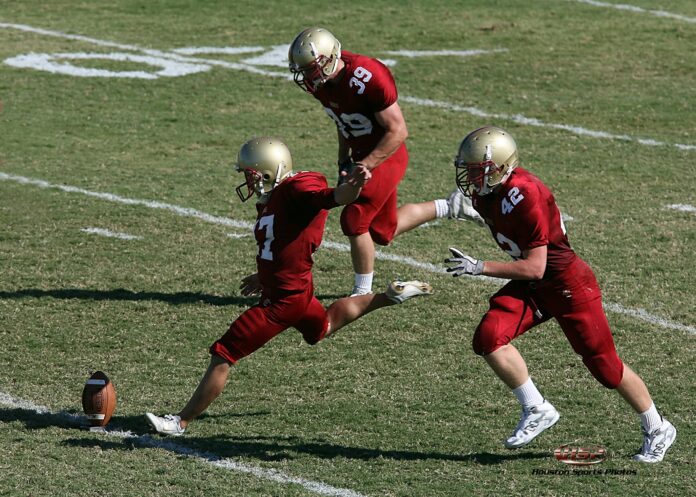As the NFL and other leagues push to improve player safety, helmet manufacturers are racing to develop a new generation of football headgear. Several companies are making light headgear that offers more energy absorption and reduces the risk of concussions.
For example, Impressio developed a helmet that uses liquid crystal elastomers to absorb impact. It also uses a floating shock suspension system to absorb the effects.
Enhanced Impact Absorption
The impact absorption of a helmet is dependent on several factors. The first is the shape of the shell. It must be able to bend and deform to absorb the impact force. The second is the padding.
The padding is made from viscoelastic materials, meaning they change shape in response to strain. This is especially true for polyurethane foam, which can absorb different impacts.
The foam moves and flexes during an impact to absorb rotational and impact forces. This reduces the likelihood of rotational injuries, a common source of head trauma in football.
This innovation can also help improve the protection of other sports, such as hockey and soccer. The softer foam absorbs impact better than the more rigid material, and this helps to protect athletes who are playing these games regularly.
In addition to absorbing the impact, the softer foam can dissipate heat from the crash. This helps keep the wearer cooler for a more extended period, which can lead to fewer missed practices and games.
Despite these advantages, many players continue to struggle with head injuries. This has led to a growing demand for improved helmets that can better absorb impact and prevent head injury. This has driven research to develop new solutions. Researchers are now using simulation technology to create safer, more durable helmets that withstand various impacts.
Reduced Concussion Risk
Soft shell helmets for flag football, which have become the future of player safety, provide a significantly reduced concussion risk. The reason is that helmets are designed to spread the impact force over a larger area, dissipating it and minimizing the force that can enter the skull.
In addition, hard helmets do a reasonably good job of protecting against translational movements — back and forth or side-to-side hits that damage the brain. However, they fail to protect against rotational impacts — a blow to the head that twists and causes cells to shear.
One way to reduce the rotational impact a player receives is by using a facemask. These can absorb a glancing blow but also increase the likelihood of neck injuries because it deflects any other impacts the player gets.
Another way to reduce the rotational impact a player receives is by adding a layer of foam to the helmet that decreases the force that the helmet creates when hit. This is an idea that a former Harvard football player introduced.
Johns Hopkins has tested soft shell design under a research contract, significantly lowering concussion rates. Youth leagues and high schools have adopted the helmets but are only now entering the professional ranks.
Reduced Head Injury Risk
Softshell football helmets provide a layer of soft and comfortable protection while still providing the best impact absorption. This innovative technology absorbs shock, redistributes the impact to prevent a head injury, and dissipates the energy through impact vents before it can strike the brain.
Another way that soft shell helmets reduce head injuries is through reduced g-forces. Researchers have found that adding a foam layer on the inside of a helmet can cut down g-forces by up to 25%.
Researchers extensively reviewed studies using football helmets to see if this additional foam could help reduce concussions. They screened articles for eligibility and excluded duplicates, as well as studies that used laboratory-based helmets or were performed in alternate populations.
They also excluded studies that used the same helmet type and tested impacts on a single player. Then, they evaluated a range of impact severity measures for the padded helmet shell cover equipped with and without a foam layer.
For each helmet, six impact locations were impacted by a pneumatic linear impactor to simulate various subconcussive and concussive impacts at three impact velocities (3.5, 5.5, and 7.4 m/s). Four of the six locations covered by the padded helmet shell cover were on the helmet shell, while two were found on the facemask. The results showed that the padded helmet shell cover significantly reduced HARM (P 0.0001) and DAMAGE (P 0.001) at all impact locations.
Increased Durability
Softshell football helmets are more durable than traditional hard helmets, which can become brittle. The added durability of these helmets is a huge benefit to athletes, as it ensures that they are protected from the harshest impacts without sacrificing their comfort and safety on the field.
A significant factor that makes these helmets durable is the design. These helmets have a built-in shock absorber that helps prevent force from transferring to the player’s head and neck.
In addition, they have a unique faceguard that allows the player to keep their head in place and reduces head impact. The faceguard also has a chin strap that keeps the helmet in place.
Another factor that makes these helmets durable is the material used for the outer shell. The material is a non-Newtonian substance that changes its viscosity with shear stress.
The results of this study show that an outer shell made from this material can significantly reduce both linear and rotational acceleration. This is a significant reduction in the forces that can be transferred to the head, which can help to lower the risk of concussions and head injuries.










